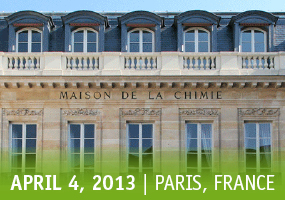|
|
Chemspace Session
Navigation in Chemistry Space Towards Biological Activity
 | Dr Peter ERTL
(NOVARTIS INSTITUTE FOR BIOMEDICAL RESEARCH, Basel, Switzerland)
Read more
Peter Ertl studied organic chemistry and received his PhD at the University of Bratislava before joining Ciba-Geigy in Basel. After a merger with Sandoz to form Novartis he became Head of the Cheminformatics group in Pharma Research, responsible for development of new methods for the calculation of molecular properties and cheminformatics tools. Peter is author of more than 100 publications and book chapters concerning all areas of cheminformatics and computational chemistry. In the cheminformatics community he is best known as author of the JME structure drawing applet and the fast fragment based method to calculate molecular polar surface area.
http://peter-ertl.com Close window |
Feature-based Pharmacophores for Molecular Profiling
 | Prof. Dr Thierry LANGER
(PRESTWICK CHEMICAL, Vienna, Austria)
Read more
Prof. Langer, CEO and President of Prestwick Chemical, is a well known scientist in the drug discovery field. Former Professor of pharmaceutical chemistry at Innsbruck University (Austria), and co-founder of the software company Inte:Ligand GmbH (Vienna, Austria), he is author of more than 160 original papers in the field of computational medicinal chemistry. Close window |
The Chemical Space Project
| Prof. Jean-Louis REYMOND
(UNIVERSITY OF BERN, Bern, Switzerland)
Read more
Jean-Louis Reymond is Professor of Chemistry and Chemical Biology at the University of Berne, Switzerland. He studied chemistry and biochemistry at the ETH Zürich and obtained his Ph.D. in 1989 at the University of Lausanne in the area of natural products synthesis. He was then post-doctoral fellow and Assistant Professor at the Scripps Research Institute in La Jolla, CA. In 1997 he joined the Department of Chemistry and Biochemistry at the University of Berne. His current research includes the development of peptide dendrimers as artificial proteins and glycoproteins, drug delivery and antimicrobial agents, computer-aided drug design and cheminformatics.
Close window |
Biospace Session
Systematic Mapping of Target-Ligand Interactions Using Compound Activity Data
 | Prof. Jürgen BAJORATH
(UNIVERSITY OF BONN, Bonn, Germany)
Read more
Jürgen Bajorath obtained his diploma and Ph.D. degrees in biochemistry from the Free University in West-Berlin. He was a postdoc at Biosym Technologies in San Diego. From 1991-2004, he held several research positions in Seattle including the Bristol-Myers Squibb Pharmaceutical Research Institute, a biotech start-up, and the University of Washington. In 2004, he was appointed Professor and Chair of Life Science Informatics at the University of Bonn, Germany. He continues to be an Affiliate Professor at the University of Washington. His research focuses on chemoinformatics and the development of computational methods for drug discovery and chemical biology. Close window |
Merging Chemical and Biological Spaces
 | Prof. Gabriele CRUCIANI
(UNIVERSITY OF PERUGIA, Perugia, Italy)
Read more
Trained in physical organic chemistry and chemometrics he learned bio-simulation and CADD in the Laboratory of Molecular Biophysics at the University of Oxford and then pharmacokinetics and metabolism in the Institute of Medicinal Chemistry of the University of Lausanne.
For his contribution in molecular modelling he received the “Hansch Award” from the QSAR and Modelling Society (USA) in 2001, the ‘’Research Award’’ from the Organic Division of the Italian Chemical Society in 2005, and the “Novartis Lectureship Award” from Novartis in 2009.
Today he is the scientific director of the Human Cytochrome Consortium Initiative, a Consortium of eight drug companies which cooperate in studying the problems on human metabolism of drugs, and full professor in Organic Chemistry at the Chemistry Department of the University of Perugia (Italy). He has authored over 170 peer-reviewed articles, written several book chapters and has held a number of patents. Close window |
Molecular Diversity : Why Do We Want it? What Do We Get?
 | Dr Ansgar SCHUFFENHAUER
(NOVARTIS INSTITUTES FOR BIOMEDICAL RESEARCH, Basel, Switzerland)
Read more
Ansgar Schuffenhauer has received PhD in the field of organic chemistry in 1998 at Georg-August-Universität Göttingen under the supervision of Lutz F. Tietze. After a postdoctoral fellowship at the University of Sheffield in the group of Peter Willett, where we worked on field-based chemical similarity searching, he joined Novartis in the year 2001 and is currently a research investigator in the in silico lead discovery group belonging to the center of proteomic chemistry. He is a member of the steering committee for the Novartis compound archive enhancement. Close window |
Perspectives
Macrocycles Approaches for Protein-protein Interactions
 | Dr Daniel OBRECHT
(POLYPHOR, Allschwil, Switzerland)
Read more
Daniel Obrecht, Ph.D., is co-founder and Chief Scientific Officer of Polyphor Ltd. He spent 11 years at the Central Research Laboratories of Roche Basle.
In his final position he was Head of the Combinatorial Chemistry Group. Dr. Daniel Obrecht obtained his Ph.D. in Chemistry from the University of Zurich under supervision of Prof. H. Heimgartner in 1985 after which he was associated with Prof. R. E. Ireland at Caltech as postdoctoral fellow for 2 years. Dr. Daniel Obrecht is author of numerous publications and books and holds several patents in the field of pharmaceuticals. He was appointed Roche Lecturer in 1993. Close window |
Enriching Chemical Space by Diversity–Oriented Synthesis of Natural Product-Like Compounds
 | Dr David SPRING
(UNIVERSITY OF CAMBRIDGE, Cambridge, United Kingdom)
Read more
David Spring is currently a Reader at the University of Cambridge within the Chemistry Department. He received his DPhil (1998) at Oxford University under Sir Jack Baldwin. He then worked as a Wellcome Trust Postdoctoral Fellow at Harvard University with Stuart Schreiber (1999-2001), after which he joined the faculty at the University of Cambridge. His research programme is focused on the use of chemistry to explore biology. Close window |
|
With the support of
Sponsor of the bags
|













